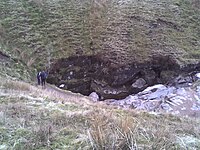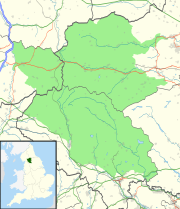|
Gaping Gill
Gaping Gill (also known as Gaping Ghyll) is a natural cave in North Yorkshire, England. It is one of the unmistakable landmarks on the southern slopes of Ingleborough – a 98-metre (322 ft) deep pothole with the stream Fell Beck flowing into it.[3] After falling through one of the largest known underground chambers in Britain, the water disappears into the bouldery floor and eventually resurges adjacent to Ingleborough Cave.[1][4] The shaft was the deepest known in Britain, until Titan in Derbyshire was discovered in 1999.[5] Gaping Gill still retains the records for the highest unbroken waterfall in England and the largest underground chamber naturally open to the surface. Features Due to the number of entrances which connect into the cave, many different routes through and around the system are possible. Other entrances include Jib Tunnel, Disappointment Pot, Stream Passage Pot, Bar Pot, Hensler's Pot, Corky's Pot, Rat Hole, and Flood Entrance Pot. The Bradford Pothole Club around Whitsun May Bank Holiday,[6] and the Craven Pothole Club around August Bank Holiday,[7] each set up a winch above the shaft to provide a ride to the bottom and back out again for any member of the public who pays a fee. A detailed 3D model of the chamber has been created using an industrial laser rangefinder which showed that its volume is comparable to the size of York Minster.[8][9] History of explorationDescentsThe first recorded attempted descent was by John Birkbeck in 1842 who reached a ledge approximately 55 metres (180 ft) down the shaft which bears his name.[10] The first complete descent was achieved by Édouard-Alfred Martel in 1895. Hensler's Crawl and Master CaveOn 16 May 1937[11] Eric Hensler (1907–1991) explored a low passage leading off Booth-Parsons crawl, finding it to be unexplored. This was later named Hensler's Crawl and was also found to lead into Hensler's Master Cave.[12] Since 1937In 1983 members of the Cave Diving Group made the underwater connection into Ingleborough Cave. An extreme rock-climb (graded E3, 5c) is possible up the main shaft which requires very dry conditions. It was first pioneered in 1972 with ten points of aid. The first free ascent was made in 1988.[13] See alsoReferences
Sources
External linksWikimedia Commons has media related to Gaping Gill. |
||||||||||||||||||||||

